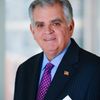A few weeks ago, a Minneapolis driver dropped her cell phone on the passenger side floor, reached to pick it up, and slammed into a stopped car in front of her. She killed Grayson Paul Earl Jett, a 14-month-old boy, in a tragic pattern of events that repeats itself on roadways across the United States.
During the last few years, distracted driving has evolved from a dangerous practice to a deadly epidemic, perhaps the least recognized public safety crisis of the 21st century.
Talking, texting, emailing, entering data into a GPS, and other distractions contribute to 6,000 deaths -- and more than 500,000 injuries -- every year. Yet, seven of 10 people between the ages of 18 and 49 readily admit that, even though aware of the danger, they remain unwilling to put down their electronics and concentrate on the road. The results are 100 percent preventable accidents that shatter the lives of too many families. The victims are not just statistics. They are our mothers and fathers, sisters and brothers, or toddlers like Grayson, strapped in his car seat, along for a ride with his dad.
But there is good news. Drivers can and do change their behaviors. For example, drunk driving fatalities have decreased by 14 percent during the last two years. Here's another: 84 percent of Americans now buckle up whenever they get into a car, up from 60 percent only 15 years ago. Why? A mix of stronger laws, more effective enforcement and strategic public outreach.
Informed by these recent, early successes, a coalition of lawmakers, enforcement officers and citizen advocates are drafting a roadmap to the day when distracted driving is a behavior of the past. We could not ask for a better partner than Oprah Winfrey and her No Phone Zone initiative. Because of our common efforts, six states have banned handheld cell phone use for all drivers while another 23 have outlawed messaging behind the wheel. And we're just getting started.
For the Obama administration's part, the President has prohibited all federal employees from texting while operating a government car -- and from using a government mobile device while operating a private car.
The Department of Transportation has forbidden commercial truck and bus drivers from messaging on the job. We've provided sample legislation, endorsed by both safety organizations and the wireless and automobile industries, for states considering policy solutions. Last month, we began two pilot programs -- one in Syracuse, New York, and the other in Hartford, Connecticut -- that test whether highly visible enforcement and an aggressive public advertising campaign can change our neighbors' minds and actions.
For more on our efforts, please visit www.distraction.gov or my blog, The Fast Lane.
Still, we must do more. Lives are at stake. And I'm thrilled that Oprah will devote her entire April 30 show to promoting National No Phone Zone Day.
Together, we'll raise awareness, honor the victims, and build support for this crucial cause. We can and will reach the day when no other families like Grayson's will suffer because a driver took his or her eyes off the road and hands off the wheel.
